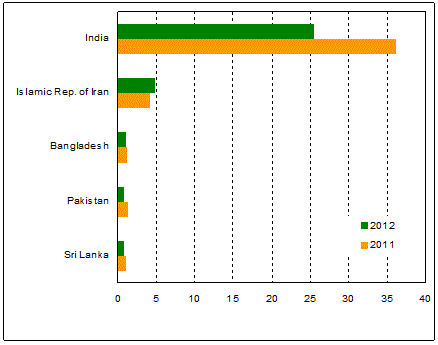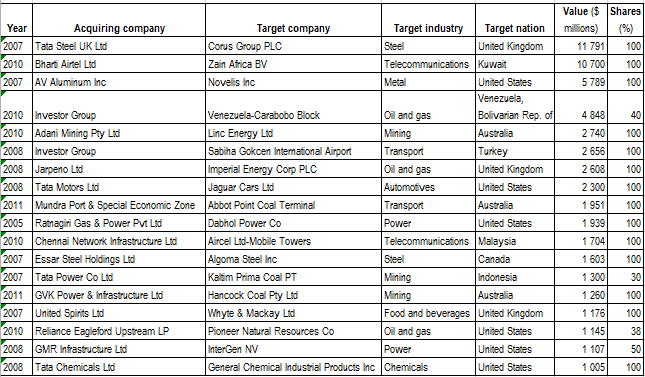Foreign direct investment (FDI) inflows to South Asia declined by 24 per cent to US$34 billion in 2012, UNCTAD’s World Investment Report 2013 reveals. It says decreases were recorded by India and other major countries of the region.
The World Investment Report 20131, subtitled Global Value Chains: Investment and Trade for Development, was released today.
South Asia saw sharp declines during the year both in cross-border mergers and acquisitions (M&As), and in greenfield investments – that is, investments in new industries or economic sectors of recipient countries, the report adds.
FDI inflows to India dropped by 29 per cent to $26 billion; inflows to Pakistan fell by 36 per cent to $847 million; and inflows to Sri Lanka declined by 21 per cent to $776 million (figure 1).
Bangladesh saw incoming investment decrease too, by 13 per cent, to about $1 billion. Nevertheless, the country remained the third-largest recipient of foreign direct investment (FDI) in the region, after India, and the second-placed Islamic Republic of Iran, where FDI increased by 17 per cent, reaching $5 billion, a historic high.
The Indian economy experienced its slowest growth in a decade in 2012, and also struggled with risks related to high inflation, the report says. As a result, investor confidence was affected, and FDI inflows to India declined significantly.
But the study contends that the country’s FDI prospects are improving. Inflows to the services sector are likely to grow, thanks to ongoing efforts to open up key economic areas such as retailing, the report says. And flows to manufacturing are expected to increase as a number of countries, including Japan and the Republic of Korea, establish country- and/or industry-specific industrial zones in the Delhi-Mumbai industrial corridor. Leveraging public funds from foreign countries, these bilateral efforts may result in an increasing amount of FDI targeting industries such as electronics in India in the years to come.
A number of countries in the region, including Bangladesh, India, Pakistan and Sri Lanka, have emerged as important players in the manufacturing and export of ready-made garments. Linking these countries to global value chains and markets, contract manufacturing has helped to boost productive capacities in the apparel industry in South Asia. Leading local contract manufacturers, such as Brandix and MAS in Sri Lanka, have started to invest in production facilities in other regions, especially Africa, the World Investment Report notes. Starting with “cut, make, and trim” production in the 1980s and 1990s, these firms established themselves in original design manufacturing in the 2000s, serving brand owners in developed countries. As “full package” garment suppliers, they have been particularly competitive in niche markets such as sportswear, swimwear and children’s clothing, the report says.
Among these South Asian countries, Bangladesh stands out as the current sourcing “hot spot” in the industry, by offering the advantage of both low costs and large capacity. However, working conditions and other labour issues are a major concern, and a number of recent disastrous accidents have underscored the daunting challenges facing the country’s booming garment industry, the report says.
FDI outflows from South Asia dropped by 29 per cent in 2012, to $9.2 billion, the World Investment Report notes. Outflows from India, the region’s dominant FDI source, decreased to $8.6 billion, due to a shrinking in the value of cross-border M&As by Indian companies.
During the past decade or so, Indian multinationals have been active players in global M&A markets, particularly in the developed world. The report notes that among the 18 cross-border M&A deals with an investment value of above $1 billion that were undertaken by Indian companies in the 2005–2011 period, 13 were in developed countries, most notably the United States, the United Kingdom and Australia (table 1). However, none of these deals took place in 2012; Indian companies seemed to be much less active in international M&A markets than in previous years, and were increasingly focused on their domestic operations, the report says. As a result, the total value of cross-border M&As undertaken by Indian companies dropped by nearly three fifths in 2012, to about $2.6 billion.
Full Report - http://unctad.org/en/PublicationsLibrary/wir2013_en.pdf
Figure 1. Top 5 recipients of FDI in South Asia, 2011 and 2012
(billions of US dollars)
Source: UNCTAD. World Investment Report 2013.
Note: Countries are ranked on the basis of magnitude of 2012 FDI flows.
Table 1. Largest cross-border M&As by Indian TNCs, 2005-2012
Source: UNCTAD. World Investment Report 2013



